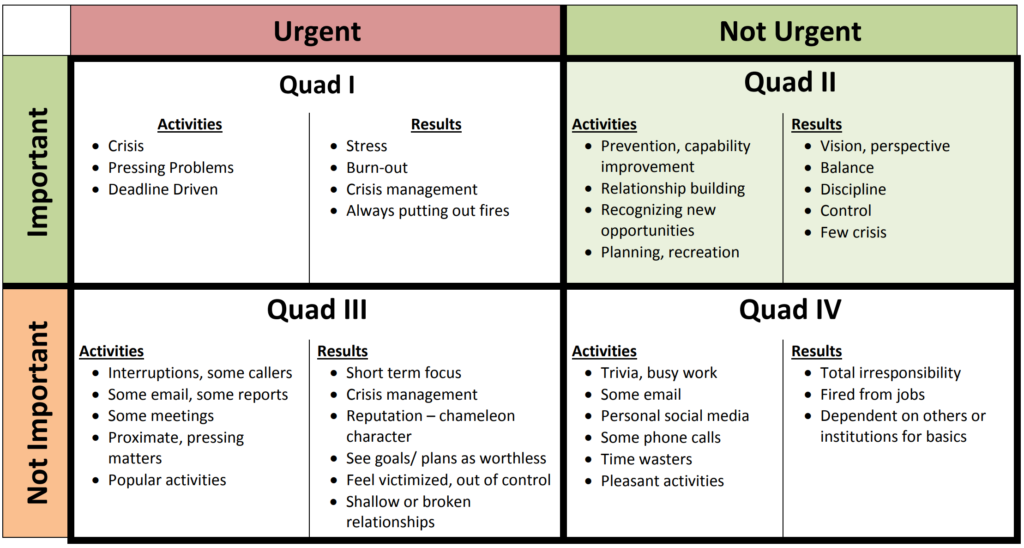One-on-one meetings are the most critical regular interaction between a manager and an employee. They lay the foundation for a healthy relationship with your employee, boost performance, and enhance job satisfaction. For the time investment, they are one of the best ways to positively impact your employees.
The primary goal of a one-on-one meetings is to build trust and rapport with your employee. They also provide an opportunity to make incremental behavior adjustments and share information on a deeper level.
It is important to note that the goals have nothing to do with project/task updates, evaluations, casual conversations, or griping. Those topics can be discussed elsewhere in the organization, with the aim of minimizing negative talk. By following this approach, we can ensure that our one-on-one meetings are truly effective and contribute to a positive and productive work environment.
Frequency and Duration
To maximize the effectiveness of your one-on-one meetings, it is important to maintain a regular schedule while keeping them concise. A weekly one-on-one meeting is optimal. Anything less than that will result in missed opportunities to foster trust and can create a sense of urgency to cover too much ground in a single meeting. Moreover, infrequent one-on-one meetings may inadvertently shift their focus towards evaluations rather than meaningful conversations.
Limit the duration of these meetings to a maximum of 30 minutes. Exceeding this timeframe often leads to less productive discussions and diminishes the overall value of your one-on-one meetings. Remember, if certain topics remain unaddressed due to time constraints, rest assured that another meeting awaits next week.
Preparation
To ensure your one-on-one meetings hit the mark, a little preparation goes a long way. Without it, you might find yourself stuck in a loop of small talk and griping. You want to identify a few high-value questions or topics, no more than three, that you would like to discuss with the employee. For those familiar with Stephen Covey’s The 7 Habits of Highly Effective People, you are looking for most of your conversation to be in the Important, Non Urgent quadrant in the time management matrix. This way, you’ll keep the conversation meaningful and avoid getting caught up in trivialities that may feel urgent but aren’t really that consequential in the grand scheme of things.

Keeping our goals in mind, this means we are looking for topics that:
- Improve the employee’s work environment.
- Make small course corrections where the employee needs improvements.
- Learn about what motivates the employee.
- Discover what the employee aspires to.
- Add clarity to the employee about what’s happening in your department and organization.
- Gather feedback on yourself and your organization.
- Deep dive into what the employee is working on.
Here are a few places to help you find your topics:
- Review your notes from the prior meeting and identify if there are any items that you need to follow up on.
- “Last time, we discussed some strategies to reduce the number of deployment errors. Were you able to try those this week? How did they work?”
- Consider if there is any praise to be given or issues to address.
- “I heard from Sally on the conversion team that you were instrumental in solving the data load problem on Saturday. She was very grateful and was impressed with your database knowledge.”
- “Over the last couple of sprints, I’ve seen a significant decrease in your velocity. Tell me more about the types of issues you are running into.”
- If there was any significant organizational news, you could ask if the employee had any thoughts or questions about it.
- “How will the restructured IT department announced on Wednesday affect your day-to-day work?”
- Bring up notable events you’ve heard about on their project.
- “The team’s last sprint didn’t end well, and there were more bugs than usual. What do you think may have contributed to that?”
- Revisit their career goals.
- “When we last talked about your future, you indicated you wanted to start some software architectures. You’ve helped Joey with the architecture on your current project. How has that gone? Have your thoughts on architecting software changed with you new experiences?”
- You can grab from a set of canned questions like this one which has some good questions for getting feedback on yourself and your organization.
There is software that can help you facilitate the structure of your one-on-one meetings. If your organization does not have such software, it is easy to setup a system of your own. Start with a shared document between you and your employee. During the week, make refresher notes about things you observe in this document. Then, about a day before your one-on-one meeting, add your topics and questions for the next meeting. Send a reminder to the employee to review your topics and add their own. Keep the document fairly informal and make it work for you and your employee.
One-on-One Meeting
With the preperation done, it is time to have the meeting. Consider this meeting to be one of the least flexible appointments on your calendar. Avoid moving this meeting to accomodate scheduling conflicts with other people. If, for instance, the meeting cannot take place at the usual time due to the employee being out of the office, make every effort to reschedule it as close to the original time as possible. Cancelling the one-on-one meeting should never be an option. Demonstrating the importance of this meeting to the employee builds trust and reinforces its significance.
In terms of the meeting location, ensuring privacy is a priority. If you’re both in the office, that could be your office or a meeting room, with the door closed. If one or both of you are remote, make sure you choose quiet locations, away from others. Even if it is away from other co-workers, avoid locations like the coffee shop where distractions abound.
At the start of the meeting, unless you have something urgent to discuss (which should be rare if you focus on the right topics), always open the meeting by asking if there’s anything the employee would like to discuss that’s not on the agenda. Remember, this is a meeting primarily for the employee’s benefit, so prioritizing their questions and concerns typically yields better outcomes than addressing your own.
As a general guideline, about 75% of the meeting should be spent with the employee talking. This allows them to work through their issues and share their needs and desires. It is still a 2 way conversation though, contribute your thoughts when appropriate.
During the meeting, strive to be as transparent as possible. Be candid about everything. If the employee asks about rumors you’re aware of, provide the information you can and offer an estimated timeframe for further updates. If they inquire about matters you’re uncertain of, gather their knowledge and commit to following up with the appropriate individuals who can provide more information. When employees have unanswered questions, they tend to fill the gaps with worst-case assumptions, so do your best to address as many gaps as possible.
As the conversation progresses, take notes in the shared document capturing the key points discussed. If feasible, share your screen with the employee so they can see what you’re recording.
By default, anything shared by the employee in your one-on-one meetings should be treated as confidential between the two of you. However, there may be instances where a conversation needs to be discussed with others. In such cases, consult with the employee on how they would prefer it to be handled. If they have an issue with a coworker or the organization, determine if they wish to remain anonymous or if you can use their name when addressing the matter. Always ensure they understand what information will be shared and with whom, respecting their trust.
Conversely, always assume that what you share with the employee may be relayed to others. Don’t be caught off guard if someone asks you about a conversation that took place solely in a one-on-one meeting.
With approximately 5 minutes remaining, begin wrapping up the meeting. Ask one last time if anything else comes to mind that they would like to discuss. If there is, either have a quick conversation about it or add it to the agenda for next week. Be sure to conclude the meeting on time, respecting everyone’s schedules.
Post Meeting
After concluding the meeting, it’s time to shift gears and move into the summarization phase. It’s a good practice to keep the 15 minutes immediately following your one-on-one meetings clear on your calendar. This allows you to carry out this step while the conversation is still fresh in your mind. Trying to revisit it later, after a day filled with project updates and addressing urgent matters, may cause you to lose valuable context.
During this post-meeting period, take some time to tidy up your notes and send a summary message to the employee. Include a concise list of action items with specific deadlines for both yourself and the employee. Additionally, if there were any topics left unaddressed, make a note to revisit them later. It’s crucial to follow through with your action items within the agreed-upon timeframes. Failing to do so can significantly undermine the trust you are actively building with your employee.
Remember to retain your notes for future reference, especially when conducting employee evaluations. Your notes should serve as a valuable resource, allowing you to summarize the progress the employee has made. These insights will contribute to the evaluation process and help provide an accurate reflection of their achievements.



